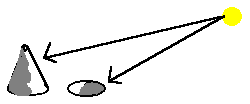

Photographs by Gus van Veen & Jan Brouwer,
Used by Permission, "Rock Art in the British Landscape" (www.rockartuk.tk)
Below are some animations showing the effects of shadow and how our interpretation of shadow is dependent upon our assumptions as to the direction of the sun.
This first image is of a stone carving found in many places in the United Kingdom and was sent to me by Gus van Veen & Jan Brouwer. These rosettes are a variation to the more common cup-and-ring motifs which were pecked out in the outcrop rock in the late Stone- and early Bronze age (3500-2000BC) with stone tools. This one is from Ormaig, north west of the village of Kilmartin in Argyll on the west coast of Scotland. When the picture was taken, the light came from the left as indicated by relative position of the sun shown below. The figure is made by carving into the stone so the image is a series of indentations. When the image flips the viewer still assumes that the sun is from the same direction. However the shadows are consistent with bumps not an indentations and so the figure looks like raised bumps not to be carved into the stone. Let the image flip a few times and see for yourself.
 |
|
Part of the way our perception of shadow works is by our expectation of the direction of the sun. The following diagram illustrates this point.

A shadow is on the far side of a mound and the near side of an indentation. However, to be able to interpret these differences, our brain must make some assumptions about the direction of the sun. One basic assumption is that the sun comes from above. This assumption helps the view make a coherent interpretation of an image. If the assumption is violated, then our perceptions can be tricked as in these examples.
This second animation to show that the last example was not a fluke is picture taken of a bone in the large wall at Dinosaur Nation Monument. In this case the sun is coming from the right as shown. When the animations begins, the top of the dinosaur bone looks cured inward towards the wall in which it is embedded. When it rotates the other way, the shadow gives the impression that the same part of the bone now is a little mound.


Here is a final animated gif of a dinosaur bone that shows the same effect (if not as pronounced, at least for me).


by John Krantz, Copyright 1999, 2003